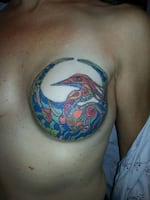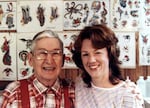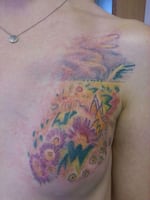
A stunning bird covers the areola and the entire breast of this survivor.
Courtesy of Mary Jane Haake
Portland’s reputation as one of the most tattoo-friendly places in the country is well earned, according to Mary Jane Haake.
“This is definitely Ink City: 243 tattooers in 10 square miles,” Haake said.
The local tattooer has a reputation herself, in part due to her unique place in the field. Haake specializes in medical tattooing: inking nipples and areolas onto breast cancer survivors who've had mastectomies. "Willamette Week" recently named her "Portland's Best Nipple Tattooist."
Speaking on OPB’s "Think Out Loud," Haake explained that she fell into the field almost by accident. As an art school student in 1970s Portland, she was given an assignment: Go into a building you’ve never been into and think about how “anything can be art, even a lawnmower.” It so happens that the storefront she chose was the tattoo parlor of fabled old-school tattooer Bert Grimm, then 78 years old. Haake was so impressed by him and his tattooing stories that she soon became his apprentice.

Portland tattooer Mary Jane Haake with her mentor, Bert Grimm.
Courtesy of Mary Jane Haake
In his younger days, Grimm had been mentored by tattoo legend Sailor George, who passed a recipe book for hand-mixing inks down to his student. Grimm used them to do tattoo work on people who’d suffered burns or exposure to mustard gas during World War I. It was as his apprentice that Haake learned about medical tattooing. One day, she recalled, their first breast cancer reconstruction client walked into the shop.
“I had no idea how to fix her, because we only had blue, red, black and green. And [Grimm] pulled out Sailor George’s 100-year-old recipe book and said, ‘I don’t want to offend you, ladies, but lips and nips are the same color.’ And he had a mixture for mustard gas people. So he mixed up lips, and we used them to put on her areolas, and he passed that recipe book down to me,” Haake said.
From there, she said her practice "grew on its own — and unfortunately, breast cancer grew on its own too." As breast cancer incidence rates increased over the following decades, so did the number of patients who came to Haake for help. In the late 1990s, federal reforms expanded insurance coverage of breast reconstruction for mastectomy patients, including tattooing. So Haake went through the process of getting credentialed with insurers. Her experience working in a burn unit made her a good candidate. Today, her shop is one of the few places in the country where patients can get their breast tattoos covered by health insurance.
As the owner of Dermagraphics, Haake tattoos over 2,500 people a year. Her patients are women and men, ranging from high school students to senior citizens. In addition to recreating natural-looking nipples and areolas, Haake also offers more artistic breast tattoo designs, which tend to appeal to her younger clients and the 65-and-up crowd.
Haake said that for many breast cancer survivors, post-surgical breasts trigger a kind of “missing parts syndrome. It’s that daily reminder that you have cancer ... It’s my job to put them back to normal — or, their new normal. So that the first thought they have every time they brush their teeth in the mirror isn’t, ‘Ugh, I’ve got cancer.’”
For some, being tattooed by Haake can mean feeling more at ease in a marriage or relationship. For others, she said, it can mean the freedom to go to the gym, a hot tub or Bagby Hot Springs.
“It’s about being able to move through your life with confidence and authority again," she said.
To hear the full "Think Out Loud" conversation with Mary Jane Haake, click the "play" button at the top of this page.

